I write as a citizen of Delhi, from my experience of its growth and development. But the observations here are indicators of what attends the fate of many cities in the country as the juggernaut of urbanisation reaches across its dimensions.
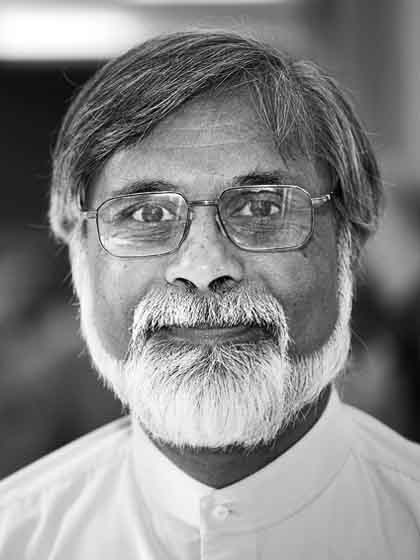
Cities are not static but growing and changing rapidly; with them grow the expectations of improvement. But recently, this promise for betterment seems to be overridden by some vicious cycle at work. I often despair, seeing the city become an inhospitable and hazardous wilderness, albeit with occasional havens like my home or the neighbourhood park. These havens are preserves of different groups of people, seeking an extension of control over the surrounding wilderness, exerting the dominance of its own ideal over the rest. Some groups are outcasts, relegated to the wilderness where they seek sustenance and hope to establish their haven. This wilderness is a contested space. When and how will it turn into that friendly forest or the garden of communion of my dreams?
My immediate encounter with the wilderness of the city is the sheer physicality of it: dust, noise, fumes, fear of being hit or run over, of picking my way through rubble, refuse and urine stinking in the blistering heat. I grow more fearful as I see increasing numbers being forced into this wilderness by the compulsions of living in the city. There is no respite from it – except, of course, for those few who put on their blinkers and have the luxury of flying in their bubble from one feathered nest to the next. For the rest, there is little escape from the encircling wilderness. The stress of living in the city increases progressively as you descend the socio-economic pyramid. The shortage of land, rationed water and routine power cuts exacerbate the existing disparities of income and wealth. These large numbers at the bottom must cling on to what they have and assiduously build a secure perch.
These symptoms can be traced to the three strands of the city’s DNA that determine its evolution. The first strand is the city’s political economy – who rules the roost, who determines its purposes, and whose imagination constructs its vision for the future. The second strand is that of the public institutions of city planning and management – their ideological moorings, their capabilities and their competences. The third strand is the insidious aspiration for the ‘good life’ in the city, its environmental impact and physical manifestations. In the present context of rapid urbanisation, the combined operation of these strands propels the city into a vicious cycle of rising social and environmental stress. The task here is to uncover the operational pattern of this vicious cycle and, hopefully, find a way to turn it into a virtuous one.
My immediate encounter with the wilderness of the city is the sheer physicality of it: dust, noise, fumes and the fear of being hit or run over
First Strand: Political Economy
Traditionally, cities were established in the service of the powerful and wealthy. The formal, legitimised city of today continues to do so. It has made space, first for the needs of business and government; next for their masters and their white-collar employees and finally for the employed worker. The occupation of land, the layout of avenues, streets, parks and monuments and the construction of buildings, expresses this hierarchy. Excluded from this conception of the city are all those who do not belong to the recognised formal categories of an ordered society, such as migrants seeking a livelihood in the city and providers of informal services like hawkers or rickshaw pullers who form one-third the population of the city. This exclusionary division persists today even as urbanisation gathers pace. It is interesting to note that according to the last census, second tier cities are growing faster, whereas the rate of population increase in the metropolises is slowing down. This perhaps is not because of economic stagnation, but may be indicative of the stresses and costs of living in big cities. The smaller cities are relatively more affordable.
The key element of these stresses and increasing costs is the price of land. Typically, in the metros, the price of land constitutes 50% to 80% of the value of built space – be it homes, offices or shops. The policy of using the price of land as a lever for urban development leads to an artificial price spiral. Increasing the permissible FSI further increases the land price rather than make homes affordable. The State becomes complicit in this process, enjoying the revenue on property transactions and auctioning its prime land for commercial development. International economic strategy consultants are strong proponents of this approach. They ignore its impact on the quality of life for the majority of citizens and the socio-economic dimensions of urban development. Monetising land indiscriminately has two consequences: Firstly, homes close to places of economic and social infrastructure of the city become unaffordable. This increases economic and physical stress on the less well-off citizens and adds to the transportation burden of the city. The second consequence is the geographic stratification of populations according to income wherein the poorer you are, the greater the disadvantage your location in the city imposes on you. Unauthorised colonies and urban slums are an inevitable result of the harsh stratification of the formal economy of land.
Thus, in a political economy of the city driven by the market economy of land, we see increasing disparities of wealth and the geographic stratification of society. The stratification further exacerbates the wilderness of the street – have we not experienced the anxiety of commuters as we try to board an overloaded bus from a free-for-all junction?
This institutional lacuna compounds the dysfunction of public space
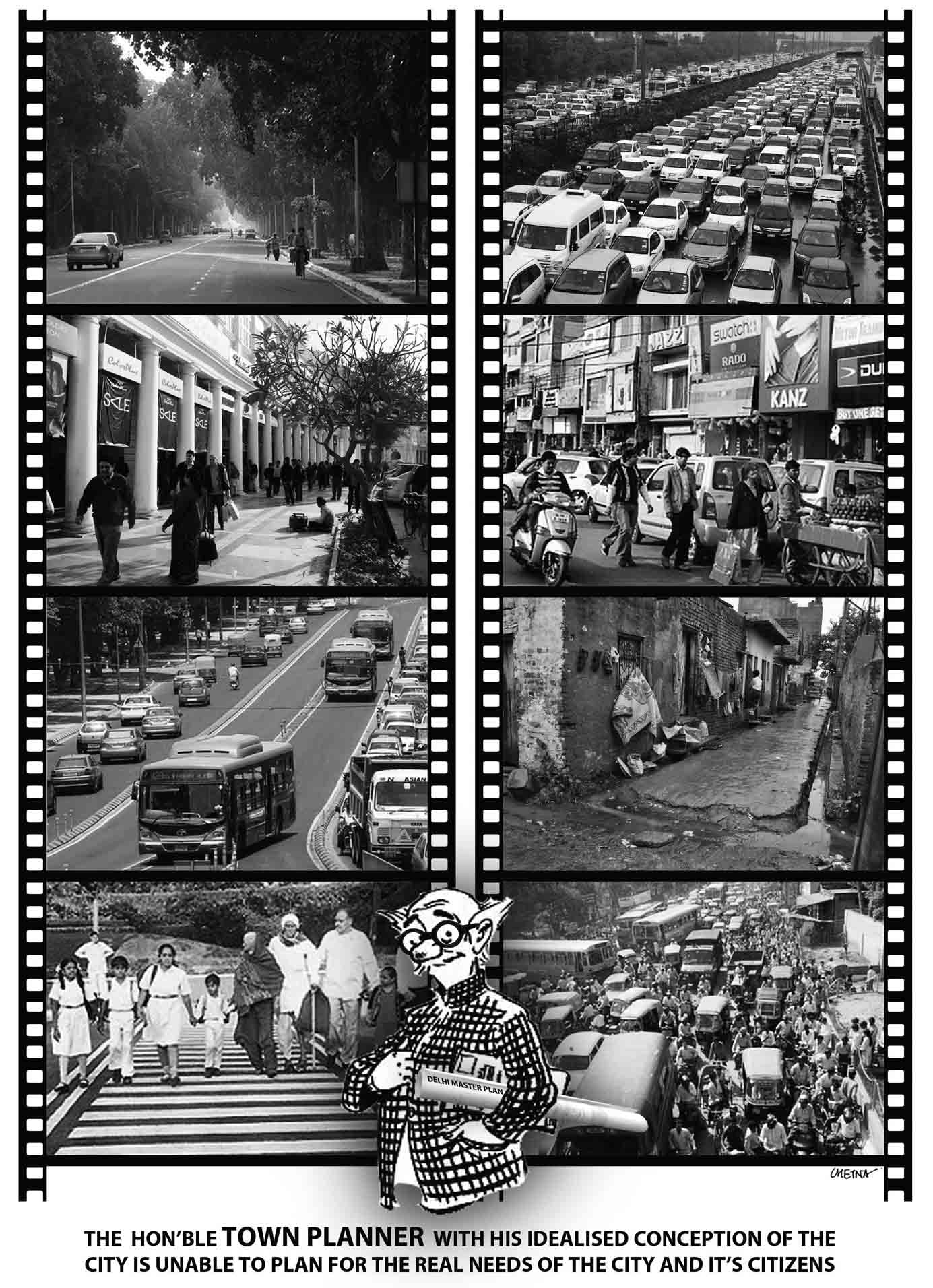
Second Strand: Ideological Moorings
Planners and the bureaucracy have been unable to provide legitimate solutions for slums and ‘unauthorised’ settlements in our cities. The legitimate city houses a mere 40% of its population. This is because both the planner and the bureaucrat are constrained by their ideological moorings. The concept ‘Plan’ for the planner represents upholding, maintaining and enforcing normative standards that define their modern city. Land is allocated for discrete activities – housing, commerce, institutions, industry etc., and rights of way for motorised transport are delineated. By and large, these standards are adopted from the new towns of Post-War Western Europe of the 1950s. This idealised creed of the planner becomes a Law, administered by the bureaucrat. Any part of the city that develops irrespective of the Master Plan will, by definition, be ‘unauthorised’ and settlements that do not meet the standards will be called ‘slums’.
Thankfully, over the past decade, town planning is beginning to engage with ‘on-the-ground’ reality rather than being an administration of idealised norms and standards. The impetus toward this shift comes largely from politics, which presses for unauthorised and slum settlements to be addressed by the planning process. The 74th Amendment to the Constitution of India, empowering Local Bodies to plan for their wards, the Urban Renewal Mission to provide low-cost housing and essential utilities for all citizens, and the Rajiv Awas Yojna to make cities ‘slum-free’, allocate finances toward this end. But the new drive toward monetising land, under the pressure of real estate speculators, works at cross-purposes to these programmes.
The ideological moorings of the planner and the bureaucrat coupled with their yen for monetising of land are the definitive roadblocks to ‘inclusive’ urban development.
Institutions of City Management
The development and care of public space is the responsibility of the City Municipality and Public Works Department. The default condition is the absence of a central institution for the Municipality that prioritises the safety and comfort of the citizen and possesses the skills of spatial and physical design to resolve the complex and conflicting demands on public space. At present, the advertising hoarding is installed such that it obscures the traffic signal from view or the open rubbish dump may stretch and spill across the road. Each provider of public facility in the public space has little concern or awareness of the other providers and, most certainly, none of them have the users’ safety and convenience at heart. This institutional lacuna compounds the dysfunction of public space.The modern planner, in pursuit of his vision of a slum-free city, administers two strategies. The first is the relocation of slums from the heart of the city to low-income colonies outside the city. The second, ‘innovative’ strategy gaining favour today is to squeeze slums into multistorey tenements subsidised by profitable privately financed commercial development. In both cases the significant gain is the legitimisation of the new homes of the erstwhile slum dweller. But the legitimisation comes with severe costs. In the former, the legitimate home is cast out and distanced from the economic opportunities of the city. In the latter, the stacking of tiny homes into 12 or more floors creates claustrophobia and alienation apart from enforcing dependence on costly lifts and pumps for basic needs. Real estate profiteers argue that high-rise, high-density developments with FSI of 3 and above are essential for a compact city form. They ignore the negative environmental and social consequences of high-rise, high-density living, especially for low-income families.
Today, the institutions of city management are more landlords and patrons than designers and enablers of the livable city for the common citizen.
Unauthorised colonies and urban slums are an inevitable result of the harsh stratification of the formal economy of land
Third Strand: Aspirations of the Urban Middle Class
The third strand of the DNA of the city is the lifestyle aspiration of the urban middle class. The two technological offerings of the 20th century: the motor car and air conditioning are now perceived as essential conveniences for a comfortable and productive modern life. We know that they have detrimental environmental impacts if allowed to run unchecked.
The Motor Car
The motor car satiates the fundamental need for safe, convenient and comfortable mobility for every individual. Though an American ideal, Indians are becoming oblivious to its consequences in India, merrily careering down the American highway. Building byelaws now require that all buildings must provide parking space within the bounds of their property often amounting to as much space as built for the primary use of the building. With an increasing demand for personalised motor cars, as against public transport and shared cars, the demand for wider roads and flyovers also increases. The resources claimed by the motor car costs the citizen, many times the cost of purchasing that motor car. No wonder that the formal ‘modern city’, that squanders land and resources in the service of the motor car, falls short of providing land for affordable homes. Further, it reduces the land for rainwater harvesting, plantation and greenery. Motor vehicles are the primary cause of air pollution. All the energy released in the combustion of fuel is heat added to the ambient air. So, to escape the heat, we resort to the other technological offering – air conditioning.
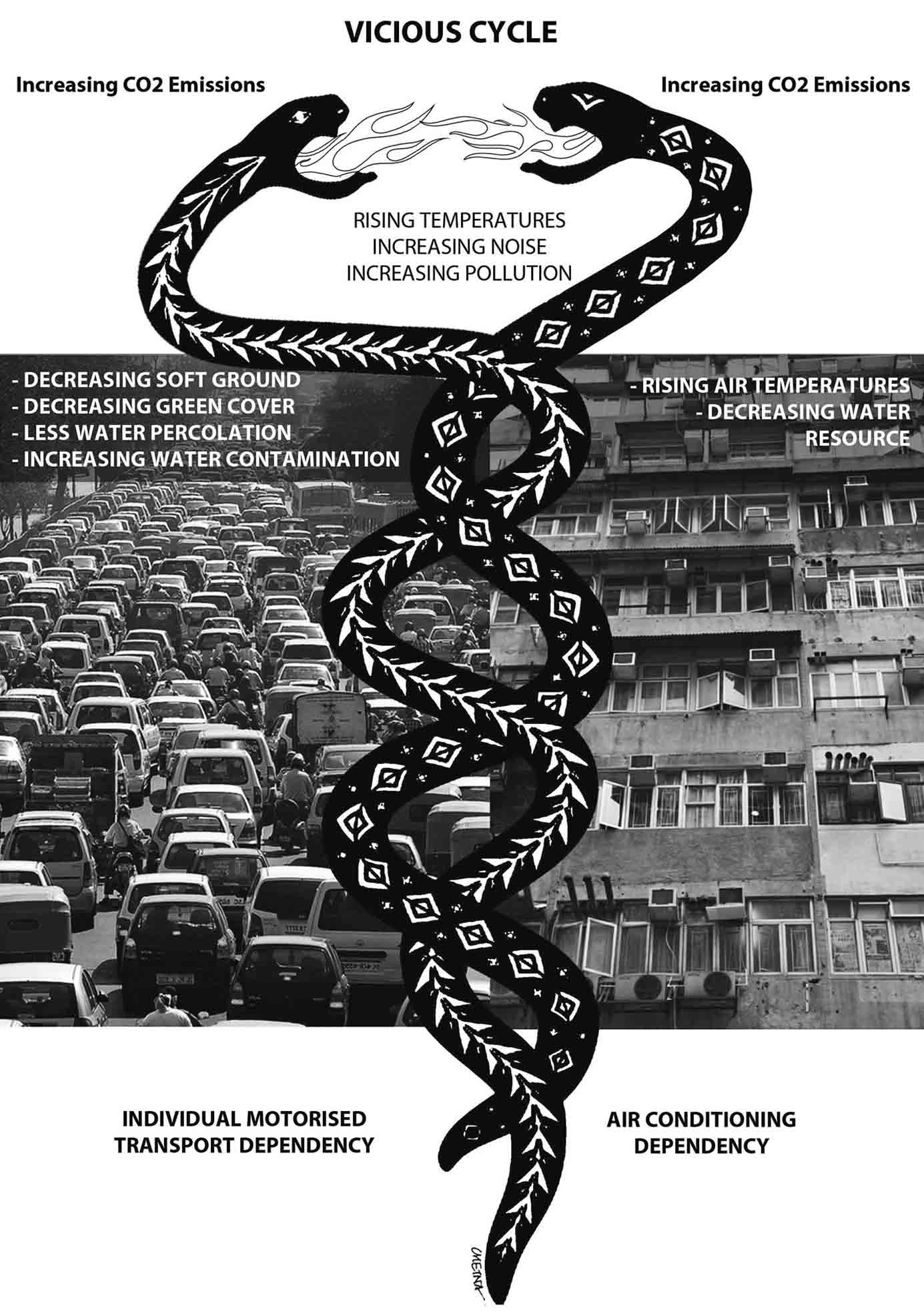
Air Conditioning
No doubt air conditioning is a great boon but it comes at a high monetary and environmental cost. The electricity consumed by the conventional air conditioner is approximately eight times the energy required by an evaporative cooler in the dry season. So, as we aspire to air conditioned comfort, we immediately incur a five-fold increase in CO2 emissions.
The carbon footprint of air conditioning will be as much as that of the motor car. The same vicious cycle develops around air conditioned buildings as around air conditioned cars. The electricity consumed by buildings to pump the heat out to its surroundings raises ambient temperatures and requires more energy for air conditioning to be effective. When we build with large quantities of glass, making solar cookers out of buildings and then resort to air conditioning, we commit an unforgivable sin.
Urban Heat Island Effect
When the motor car combines with the ubiquitous air conditioner clambering up the building walls in high-density, high-rise buildings, an intense vicious cycle is set up. The heat absorbed by road surfaces and the buildings combined with the anthropogenic heat released by the use of air conditioners, pumps and lifts can cause the ambient temperature of the city to rise 8 to 10 degrees centigrade above the neighbouring countryside. This is called the urban heat island effect. It can cause an increase of 15% in the energy consumed for air conditioning.
The aspirational culture of our urban middle class combined with high-density, high-rise development, are leading our cities into an environmental trap: higher temperatures, pollution, congestion and an unsustainable carbon footprint. We can also see the Shopping Mall (air conditioned gated streets), the gym (machine dependent exercise) gaining a grip on life-styles. India of the future would sit alongside today’s chief culprits – USA and Dubai – in its contribution to global warming.
Route to Recovery
Perhaps the city can be recovered for its citizens. One must make a beginning. Let us reconsider the three strands of the city’s DNA in reverse order.
Motor Car De-addiction
The first step to halt and reverse the vicious cycle is to withdraw our dependence on the motor car. We must reclaim the urban open spaces that the motorcar has been devouring excessively. We must make our streets walkable and cyclable – safe, shaded, convenient and pleasant. We must expand good quality public transport; make it safe, comfortable and easily accessible. We must provide space needed for hired vehicles, like rickshaws and taxis to bridge the gaps in mobility services. Fewer cars means less road space, more green spaces, more promenades along market streets and gardens, less fumes, less noise and less hazards. This is eminently doable. Many cities around the world have shown the way for careful integrated design.
Land Policy – Social Housing
The next step is not complicated either. The State must desist from fuelling the speculation of land value. State owned lands are for the public good achieved by providing affordable housing that is adequate, sustainable and conveniently located. What matters is the distribution of the benefits of city life, the distribution of opportunities to participate in the generation of wealth. The State should be responsible for the economics of land and housing that must be driven by the principle of equitable distribution.
This will require town planning and land development policy to be under the Urban Local Body, which will be the rightful expression of the 74th Amendment.
The institutions of city management are more landlords and patrons than designers and enablers of the livable city for the common citizen
Compact City – Low-rise Medium Density
Compact development and densification of low-density parts of the city are beneficial as they keep distances under check, making it suitable for cheap bus transport. Urban economists and planners need to work out a holistic pattern of densities that does not fall prey to the measurement of the wealth of the city merely in terms of the throughput of money in real estate, while turning a blind eye to the quality of life experienced by the majority of citizens.
The optimal compact city would be four to six storeys tall with FSI between 1 and 1.2. This optimises open space, rainwater harvesting and space for vegetation to create a habitable out-of-doors without the heat island effect. This pattern is optimal with reduced energy consumption in buildings with less mechanical energy needed for basic needs and access and a cooler microclimate reduces air conditioning needs. It supports public transport and mass rapid transit by bus or train. Above all, it is more affordable compared to the high-rise formula. It is 15% cheaper to build, less technology intensive, more fire and earthquake safe and suitable for all income levels. A compact low-rise, high-density form that is not motor car dependent is where the answer lies.
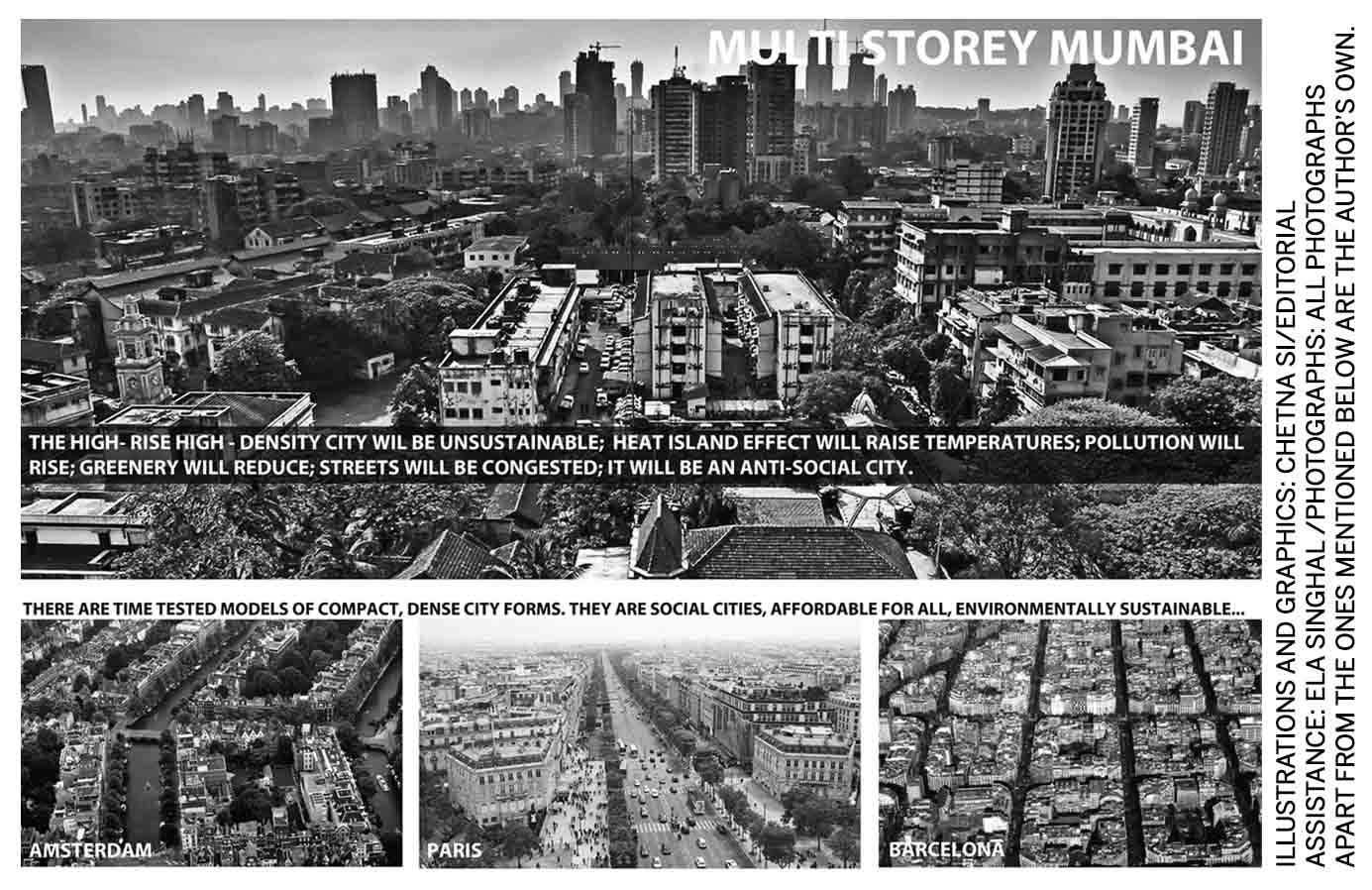
The purpose of Urban Development and Urban Planning
It is time to restate the purpose of urban development and urban planning in terms of the political economy of the city. Urban systems are to be seen as much as engines for distribution of wealth as engines for the production of wealth. The task of planning urban systems, therefore, is to take affirmative action to enhance the potential of the poorer citizens’ access to the urban economy and to minimise their cost of shelter and travel in the city. This purpose of urban development should engage the creative imagination of planners, urban economists, environmental engineers and architects.
Urban planning cannot be divorced from the imperatives of environmental sustainability
Next, urban planning cannot be divorced from the imperatives of environmental sustainability. The Environmental Law in respect of large developments already mandates this. Urban Planning cannot ignore this law. Population density and FSI are to be disciplined by long-term environmental health and environmental economics and not by monetary considerations alone.
We must first admit to the imperatives of equity and environmental sustainability. We could then look forward to a less contested ground and a more democratic, affordable and hospitable place of communion; a place of streets and gardens where we can breathe clean air and share the conviviality of free and varied encounters that enrich its creativity and enterprise.
(This is an abridged version of the article originally published in the Indian International Center Quarterly, Summer 2013.)
1) The Hon’ble Planner
- The Common Man shown as The Hon’ble Town Planner - with apologies to R.K. Laxman
- Bottom Left - http://www.delhitrafficpolice.nic.in/guidelines-for-pedestrians.htm
2) Multi-storey Mumbai
- Mumbai - http://www.skyscrapercity.com/showthread.php?t=1548682
- Amsterdam - http://www.amsterdam-hotels-travel.com/photos/aerial-2.html
- Paris - http://www.tour-beijing.com/blog/beijing-travel/beijing-tour-reviews/some-similarities-and-differences-between-paris-and-beijing/attachment/the-well-preserved-old-paris-city
- Barcelona - http://haury.pbworks.com/w/page/47144409/Eixample%20district

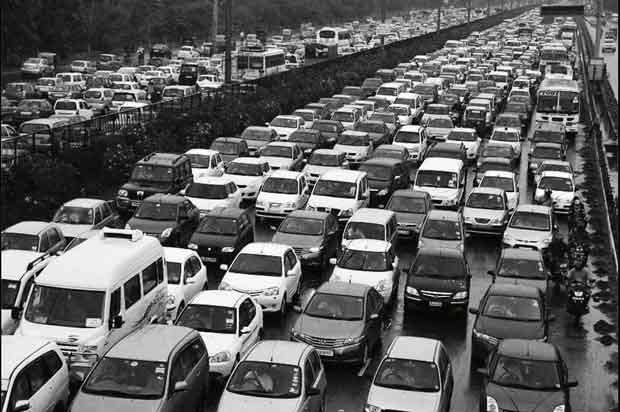

Comments (0)